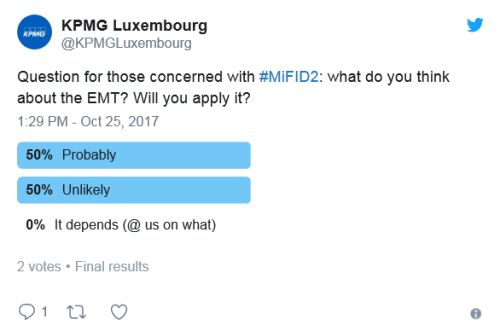In our last article we talked about possible communication solutions for fund manufacturers and distributors. We boiled it down to three main possibilities: blockchain, data repositories, or an industry reporting. Back then (June), a majority of readers voted for blockchain in an informal poll as the best option—but what's on the move is an industry reporting standard.
Introducing the European MiFID Template
In August 2017, the European Fund and Asset Management Association (EFAMA) made a proposal for an industry reporting standard: the European MiFID Template, or EMT. EFAMA states that the "use of the EMT is not compulsory, but a very large number of both fund managers and fund platforms have committed to using it, so there is likely to be pressure to adopt it to provide fund data to distributors."
So, what is the EMT all about?
It's a spreadsheet that is accessible on EFAMA's website, containing 66 items to be filled out by the ManCo as the manufacturer of the fund. The main categories deal with the definition of a target market, the distribution strategy, and the transparency of costs and charges.

The EMT in practice
In Germany, the EMT will be collected and distributed by the service provider WM Datenservice, which will act as a data repository where the EMT will be available for distributers of the fund. This centralised data repository comes with the advantage that communication is streamlined by having just one intermediary. As for Luxembourg, it is currently unclear if a similar set-up will be used. I will keep you posted on this.
What's in the EMT?
Target market definition
From my point of view, market participants are not struggling that much with defining the "target investors" of their products. With the six categories from ESMA, this exercise seems to be pretty straightforward. The current discussion is more about costs and charges.
Costs and charges
The key change is that all costs and charges must be transparent. The hottest topic right now seems to be research costs which in the past have been mainly provided free of charge by brokers in exchange for placing orders with them. Now, since this practice is not allowable anymore, fund houses are either saying that those research costs should be borne by the investors (e.g. Deka, Amundi, Schroders) or the ManCo (J.P. Morgan, Union Investment, Franklin Templeton). I do not want to get into this discussion too far at this stage.
Much more challenging when it comes to costs and charges is to provide information on ex-ante costs. Providing information about the future is always a matter of professional judgement. But how do you determine future transaction costs? Do you base it on past figures? If so, what about newly set-up funds? For PRIIPS, which has similar requirements, there is detailed guidance on how to determine those transaction costs—see Annex VI to the PRIIPs RTS whose methodology ESMA, in their recent Q&A on MiFID II, recommends applying.
As you can see, MiFID II will continue to keep us all busy until January 2018. Leave a comment below with your thoughts and questions, and watch this space for more articles on MiFID II as it develops!
The content of this article is intended to provide a general guide to the subject matter. Specialist advice should be sought about your specific circumstances.

